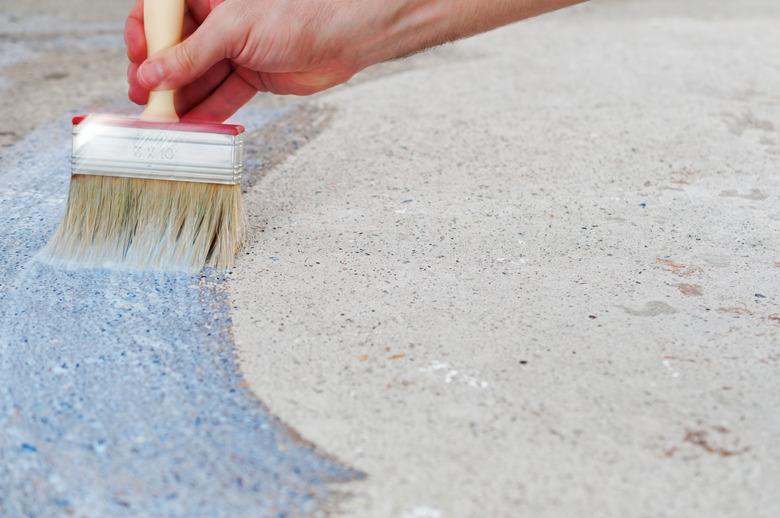How To Stain Concrete
Concrete flooring is practical, durable and attractive, making it popular with savvy homeowners. Staining with a single color or multiple colors to create designs can completely change the look of the floor. Although staining is a big job, the technique helps in preserving the concrete flooring and the aesthetics of your home.
Preparing Painted Concrete Floor
If your concrete floor is painted, it needs extra attention before staining. Use a power washer on the painted concrete to remove most of the paint. Tackle the remaining paint with a wire brush.
If the power wash method isn't effective, apply a generous amount of paint stripper. Leave the stripper on the concrete for about an hour. The paint loosens and separates from the concrete. The longer you let the stripper set, the less work you'll have to do, but don't let the stripper dry.
Spray the concrete with a garden hose to remove the gel for outdoor concrete slabs. If you're indoors, use a wet towel. Give the concrete sufficient time to dry completely.
Clean and Fill the Concrete Surface
The next step is to clean and fill the floor. Scrub the floor with a scrub brush, soap and water. Vacuum up particles on the surface. Use a crevice tool to remove debris from inside seams or cracks. The floor surface must be completely free of debris before staining.
Fill cracks with concrete glue and a woodworker's syringe. This tool includes a small needle on the end for better application and access to smaller cracks. Use a damp sponge to wipe away excess glue. Allow the glue to dry for at least an hour.
When the glue is completely dry, mix anchoring cement according to the manufacturer's directions. Using a small putty knife, press the cement mixture into any cracks in your concrete floor. Scrape away any excess mixture to ensure that the surface is completely smooth, with no bevels or creases.
After the cement dries completely, scrape away excess cement with the putty knife. Sand the area smooth with drywall sand screen.
Pre-Marking a Design
If you plan to create a pattern or design with the stain, mark the pattern before beginning. The recommended method is using painter's tape to "draw" your design on the floor. Taped areas remain stain-free, and keep the original color after the first application.
You can then remove the tape from the protected areas, apply it over the dried stained areas, and use a second color to create your design. Repeat this process as many times as needed to complete the design.
Apply Concrete Stain
Next, it's time to apply the stain. Wear protective clothing and gloves to avoid damage to clothes and skin. Mix the stain following the manufacturer's directions as precise processes vary depending on the manufacturer.
Wet a scrub brush with water, positioning the brush over your starting point. Pour a small amount of stain onto the water spot. Pouring into the puddle of water prevents the stain from creating a darker color at the initial application point.
Immediately scrub the concrete area using your water-soaked scrub brush with circular motions. This helps the stain seep evenly into the concrete's pores to react properly.
Go back over the stained area with a wet-dry vacuum to remove excess stain. This helps neutralize the stain and ensure even coverage. Clean the concrete with floor-cleaning solution and water.
Buffing and damp mopping is best accomplished with two people. One person starts in one corner, buffing concrete floors with a soft buffing pad. The second person follows right behind the person polishing the concrete with the floor buffer, using a wet-dry vacuum and damp mop to remove residue and set the stain.
Apply Faux Finishes
Faux finishing is an optional step that adds depth and visual interest to newly stained concrete floors. Apply faux finishes using acrylic concrete stain. Mix the stain with an equal amount of water, then dab the stain onto the floor with a clean, damp workshop towel.
The faux finish process allows for creativity. Explore faux painting techniques, including fan, feather and sponge processes. Allow the acrylic stain to soak into the concrete completely before sealing.
Apply a Sealer
You'll want to seal your work with clear epoxy or polyurethane sealer. Mix the sealer according to the manufacturer's directions to reach the consistency of interior paint. Use a roller to paint on the sealer, covering the entire surface. You may need to switch to a paint brush to ensure solid coverage along corners and against baseboards.
